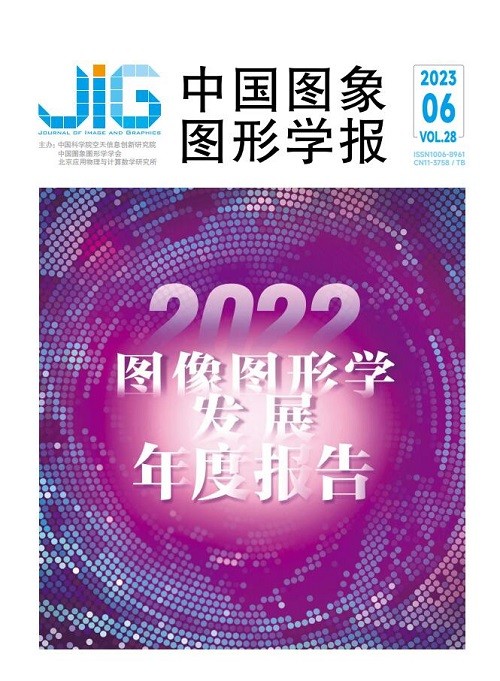
行人再识别技术研究进展
张永飞1,2, 杨航远1, 张雨佳1, 豆朝鹏3,4, 廖胜才5, 郑伟诗6, 张史梁7, 叶茫8, 晏轶超9, 李俊杰9, 王生进3,4(1.北京航空航天大学计算机学院, 北京 100191;2.北京航空航天大学虚拟现实技术与系统全国重点实验室, 北京 100191;3.清华大学电子系, 北京 100084;4.北京信息科学与技术国家研究中心, 北京 100084;5.起源人工智能研究院, 阿布扎比 5151, 阿拉伯联合酋长国;6.中山大学计算机学院, 广州 510006;7.北京大学计算机学院, 北京 100871;8.武汉大学计算机学院, 武汉 430072;9.上海交通大学人工智能研究院教育部人工智能重点实验室, 上海 200240) 摘 要
行人再识别通过大时空范围内跨摄像机目标行人图像的检索与匹配,可实现人脸等生物特征失效情况下的行人关联,已成为智能视频监控系统的关键环节和支撑技术,并在智慧公安、智慧城市等国民经济建设中发挥了重要作用。近年行人再识别技术吸引了越来越多的关注,并取得了快速发展与进步。本文在对行人再识别技术进行简介的基础上,面向行人再识别的技术发展和落地应用需求与挑战,总结分析遮挡行人再识别、无监督行人再识别、虚拟数据生成、域泛化行人再识别、换装行人再识别、跨模态行人再识别和行人搜索等热点方向的前沿进展,归纳其发展现状和存在问题,最后对行人再识别技术的发展趋势进行展望。希望通过总结和分析,能够为研究人员开展行人再识别相关研究、推动行人再识别技术进步提供参考。
关键词
Recent progress in person re-ID
Zhang Yongfei1,2, Yang Hangyuan1, Zhang Yujia1, Dou Zhaopeng3,4, Liao Shengcai5, Zheng Weishi6, Zhang Shiliang7, Ye Mang8, Yan Yichao9, Li Junjie9, Wang Shengjin3,4(1.School of Computer Science and Engineering, Beihang University, Beijing 100191, China;2.State Key Laboratory of Virtual Reality Technology and Systems, Beihang University, Beijing 100191, China;3.Department of Electronic Engineering, Tsinghua University, Beijing 100084, China;4.Beijing National Research Center for Information Science and Technology, Beijing 100084, China;5.Inception Institute of Artificial Intelligence, Abu Dhabi 5151, United Arab Emirates;6.School of Computer Science and Engineering, Sun Yat-sen University, Guangzhou 510006, China;7.School of Computer Science, Peking University, Beijing 100871, China;8.School of Computer Science, Wuhan University, Wuhan 430072, China;9.Artificial Intelligence Key Laboratory of the Ministry of Education, Artificial Intelligence Institute, Shanghai Jiao Tong University, Shanghai 200240, China) Abstract
Person re-Identification(person re-ID) technique aims to solve the problem of association and matching of target person images across multiple cameras within a camera network of a surveillance system, especially in the case of face, iris and other biometrics recognition failure under non-cooperative application scenarios, and has become one of the key component and supporting technique for intelligent video surveillance systems and applications in intelligent public security and smart cities. Recently, person re-ID has attracted more and more attention from both academia and industry, and has made rapid development and progress. To meet the requirement of its technical challenges and application needs of person re-ID in practical scenarios, this paper will first give a brief introduction to the development history, commonly used datasets and evaluation metrics. Then, the recent progress in hot research topics of person re-ID is extensively reviewed and analyzed, which includes:occluded person re-ID, unsupervised person re-ID, virtual data generation, domain generalization, clothchanging person re-ID, cross-modal person re-ID and person search. First, to address the problem of impact of possible occlusions on the performance of person re-ID, recent progress in occluded person re-ID is first reviewed, in which the popular datasets for occluded person re-ID are briefly introduced, and the two major categories of occluded person re-ID models are then further reviewed. Second, facing the challenges of low-efficiency and high-cost data annotation and great impact of training data on the performance of person re-ID, unsupervised person re-ID and virtual data generation for person re-ID emerges as two hot topics in person re-ID. The paper elaborates the recent advances of unsupervised person reID, which can be classified into three major categories:pseudo label generation-based models, domain transfer-based models, and other related models, which take into consideration of the extra information like time-stamps, camera labels besides person image. Third, the-state-of-the-art works on virtual data generation for person re-ID are reviewed, with detailed introduction and performance comparisons of major virtual datasets. Fourth, recent researches on domain generalization person re-ID will be reviewed, which are classified into five categories:batch/instance normalization models, domain invariant feature learning models, deep-learning-based explicit image matching models, models based on mixture of experts and meta-learning-based models. Fifth, since most current person re-ID models largely depend on the color appearance of persons' clothes, clothes-changing person re-ID becomes a challenging setting, in which person images can exhibit large intra-class variation and small inter-class variation. Typical cloth-changing person re-ID datasets are introduced and the recent researches will then be reviewed, in which models in the first category explicitly introduces extra cloth-appearance-independent features like contour and face while the second try to decouple the cloth features and person ID features. Sixth, to compensate the drawbacks of conventional person re-ID of visible light/RGB images in natural complex scenes like poor lighting conditions in the night, the-state-of-the-art of cross-modal person re-ID, which aims to resolve the problem through other visible RGB images-excluded heterogeneous data, are reviewed, with a brief introduction of commonly used cross-modal person re-ID datasets first and then four sub-categories models according to the different modalities employed, including:RGB-infrared image person re-ID, RGB image-text person re-ID, RGB image-sketch person re-ID, and RGB-depth image person re-ID, respectively. Seventh, since existing person re-ID benchmarks and methods mainly focus on matching cropped person images between queries and candidates and is different from practical scenarios where the bounding box annotations of persons are often unavailable, person search, which jointly considers person detection and person re-ID in a single framework, becomes a new hot research topic. The typical datasets and recent progress on person search are reviewed. Finally, the existing challenges and development trend of person re-ID techniques are discussed. It is hoped that the summary and analysis can provide reference for relevant researchers to carry out research on person re-ID and promote the progress of person re-ID techniques and applications.
Keywords
intelligent video surveillance occluded person re-ID unsupervised person re-ID virtual data generation domain generalization person re-ID cloth-changing person re-ID cross-modal person re-ID person search
|



 中国图象图形学报 │ 京ICP备05080539号-4 │ 本系统由
中国图象图形学报 │ 京ICP备05080539号-4 │ 本系统由